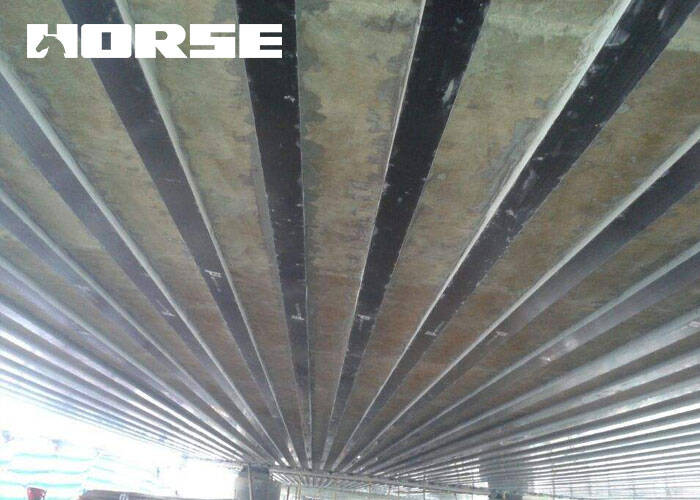Solutions
Horse Construction offers full range of structural strengthening materials with technical supports, documentation supports, products supports, project supports.
external bonding reinforcement

Overview
Since the 1970s, my country's bridge construction has developed rapidly. Among the existing bridges, reinforced concrete beam bridges (structures including T-beams, box beams and hollow slabs) are the bridge designers’ first choice due to their simple form, convenient construction, strong applicability and good economic indicators. one. However, since the 1980s, a large number of existing reinforced concrete bridges have entered a period of functional degradation after long-term use, and many diseases have appeared, and even collapsed. Taking appropriate reinforcement measures for damaged bridge structures can restore the original reliability of the structure to a certain extent and extend its service life. This undoubtedly has significant social and economic benefits. Therefore, the maintenance, repair, and reinforcement of existing structures have gradually become a focus of structural engineering, with broad application prospects.
Applicability analysis of external bonding reinforcement method
At present, the methods of strengthening and reinforcing concrete structures and components used at home and abroad include enlarged section method, wire winding method, glass fiber reinforced plastic method, external bonding steel method, external bonding reinforcement method, etc. Among them, the external sticking reinforcement method is a method in which structural glue is used as an adhesive to bond a certain thickness of engineering reinforcement material on the surface of the concrete structure to make it co-exist with the original structure, thereby improving the structure's bearing capacity and deformation capacity. This method has the advantages of short construction period, effective improvement of component stiffness and crack resistance, etc., and is widely used in engineering practice.
The bonding reinforcement method has a wide range of applications, and can be used at the bottom of the beam, the top of the beam and the diaphragm. If the concrete beam has insufficient bearing capacity at the front section and cracks appear at the bottom of the beam, reinforcement materials can be attached to the bottom of the beam. When the diagonal reinforcement in the shear area of the bridge structure is insufficient, it can be bondingd diagonally on the side of the concrete member perpendicular to the direction of the shear crack, or strip-shaped reinforcement tapes can be bondingd vertically or U-shaped and L-shaped box-shaped reinforcement tapes can be used. Ring shaft bonding can be used on the pier.
There are many types of materials available for the bonding reinforcement method. At present, two common methods are the bonding steel plate method and the fiber reinforced composite material method (Fiber Reinforced Plastics, FRP). The thickness of the bondingd steel plate is generally 4-10mm, which basically does not affect the shape of the reinforced member and the bridge clearance, and the increase in the weight of the bridge is small. The fiber composite material has a very light weight, with a thickness of 0.111-0.167mm and no more than 3 layers. At the same time, the construction is simple, and the impact on the weight of the entire reinforced structure and the clearance under the bridge can be ignored.
Classification and advantages and disadvantages of bonding reinforcement method
| Serial number | Category | Advantage | Disadvantage | Remarks |
| 1 | External bonding steel plate method | Does not affect the building space, simple construction, less wet work, good effect | The requirements on the concrete surface are high, the weight of the structure is increased, and the structural adhesive is easy to age. | |
| 2 | External bonding fiber composite reinforcement method | Lightweight and high-strength, suitable for various surface shapes, less wet work, simple construction, strong designability, easy to ensure the quality of bonding | Not exposed to sunlight and harmful media, easy to wear and damage by impact, fireproof | Common materials:CFRP, AFRP,GFRP |
Anchor bolt steel plate reinforcement method is a newly developed adhesive reinforcement technology in recent years. This method uses high-strength shear anchor bolts to fix the steel plate on the surface of the concrete member. Compared with the ordinary adhesive reinforcement method, it can effectively reduce or eliminate the peeling off phenomenon between the reinforcement board and the concrete. The anchor bolt-steel reinforcement system is used in actual engineering applications. For the connection between the anchor bolt and the steel plate, sufficient clearance must be left between the anchor bolt and the side wall of the steel plate aperture for installation. This also leads to the possibility that when the steel plate is subjected to displacement or deformation, some of the anchor bolts have not yet contacted the inner wall of the steel plate aperture, which affects the cooperating ability of the anchor bolts and greatly reduces the reinforcement effect of the anchor bolt steel plate reinforcement method.
Conclusion
At present, the maintenance and reinforcement of bridge structures have become a focus of structural engineering.
You can find anything here you are in need of, have a trust trying on these products, you will find the big difference after that.

High strength carbon fiber reinforced polymer (CFRP) strip / laminate / plate for structural strengthening and concrete repair

Two-component epoxy modified epoxy structural strengthening adhesive for bonded steel plate to concrete

High strength, unidirectional carbon fiber sheet pre-saturated to form a carbon fiber reinforced polymer (CFRP) sheet used to strengthen structural concrete elements.